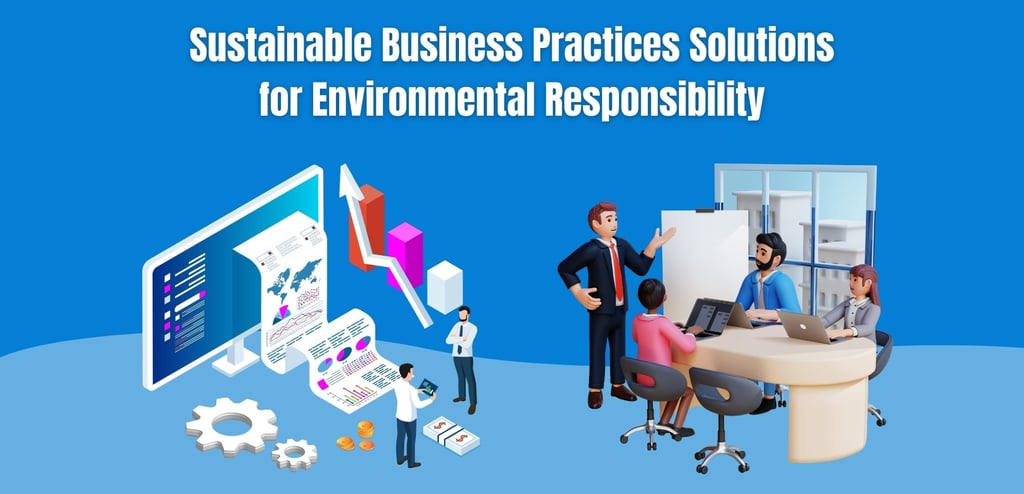
Sustainable Business Practices Solutions for Environmental Responsibility
By AZ Konnect Team
12/3/20245 min read


As global awareness of environmental issues continues to grow, businesses are facing increased pressure to adopt sustainable practices. Consumers, investors, and governments are now more concerned about the environmental impact of industries, leading companies to rethink their strategies and find ways to operate more responsibly. Sustainable business practices not only help protect the planet, but they also drive long-term growth, attract eco-conscious consumers, and boost corporate reputations.
In this blog post, we'll explore various sustainable business practices and solutions that organizations can adopt to demonstrate environmental responsibility while fostering a more resilient future.
1. Energy Efficiency and Renewable Energy Adoption
One of the most impactful ways businesses can reduce their environmental footprint is by improving energy efficiency and adopting renewable energy sources. Reducing energy consumption and transitioning to cleaner energy not only benefits the environment but also results in significant cost savings.
Why It Matters:
Lower Greenhouse Gas Emissions:
The burning of fossil fuels for energy contributes significantly to climate change. By improving energy efficiency and using renewables like solar or wind power, businesses can dramatically reduce their carbon footprint.
Cost Savings:
Investing in energy-efficient technologies and renewable energy can lead to long-term savings on utility costs.
Reputation and Compliance:
Energy-efficient practices and the use of green energy show a commitment to environmental responsibility, enhancing brand image and meeting evolving regulatory requirements.
Actionable Solutions:
Conduct Energy Audits:
Identify areas where your business is using excess energy and implement changes such as installing energy-efficient lighting, HVAC systems, and machinery.
Invest in Renewable Energy:
Consider installing solar panels, using wind energy, or purchasing renewable energy credits (RECs) to offset your company’s energy consumption.
Upgrade to Smart Technologies:
Smart meters and IoT-enabled devices can help monitor energy usage and optimize consumption based on real-time data.
2. Sustainable Supply Chain Management
A company’s environmental impact is not limited to its internal operations. The supply chain, including suppliers, transportation, and materials sourcing, plays a critical role in determining a business's overall sustainability. Creating a green supply chain can greatly reduce resource consumption and waste generation.
Why It Matters:
Reduced Environmental Impact:
Sustainable sourcing and responsible supply chain management ensure that materials and products are produced with minimal harm to ecosystems, water resources, and communities.
Ethical Sourcing:
Consumers increasingly demand transparency and accountability in how products are made. A sustainable supply chain ensures that materials are sourced ethically and that workers are treated fairly.
Cost and Risk Management:
An optimized, sustainable supply chain is often more efficient, reducing costs and risks associated with environmental regulations and resource scarcity.
Actionable Solutions:
Source Eco-Friendly Materials:
Work with suppliers that provide sustainably sourced, recycled, or biodegradable materials to reduce environmental damage.
Localize Your Supply Chain:
Reduce carbon emissions by sourcing materials and products from local suppliers, which also shortens transportation distances.
Collaborate with Green Suppliers:
Partner with suppliers that have a strong commitment to environmental practices, ensuring that your entire supply chain adheres to sustainability standards.
3. Waste Reduction and Circular Economy Practices
Waste generation is a significant environmental issue, but businesses can mitigate this by focusing on waste reduction and embracing the principles of a circular economy. Instead of the traditional linear model—take, make, dispose—a circular economy promotes recycling, reusing, and repurposing materials to extend their lifecycle.
Why It Matters:
Resource Conservation:
By reducing waste, businesses can minimize the depletion of natural resources and lower their environmental impact.
Lower Disposal Costs:
Reducing the amount of waste that ends up in landfills or incinerators leads to savings in disposal fees and waste management costs.
Improved Brand Image:
A commitment to waste reduction and circular economy practices can enhance a company's reputation as an environmentally conscious brand, attracting eco-minded customers.
Actionable Solutions:
Implement Recycling Programs:
Establish comprehensive recycling programs for paper, plastics, metals, and electronic waste. Partner with local recyclers to ensure materials are processed responsibly.
Design for Recyclability:
Develop products that are easy to disassemble, reuse, or recycle at the end of their lifecycle.
Embrace Circular Economy Models:
Explore opportunities for product take-back programs, where customers return used products for refurbishment or recycling, and design products that use recycled materials.
4. Water Conservation and Management
Water is a vital resource, but increasing global demand and climate change are putting pressure on water supplies. Businesses that use water intensively must focus on conservation and sustainable water management to reduce their impact on local ecosystems and communities.
Why It Matters:
Water Scarcity:
In many parts of the world, water is becoming a scarce resource. Reducing water consumption helps preserve water for local communities and ecosystems.
Cost Reduction:
Water conservation practices can reduce utility costs for businesses, especially in industries that require large amounts of water for production or operations.
Regulatory Compliance:
Stricter regulations surrounding water usage and wastewater discharge mean that businesses must adopt more sustainable water management practices to avoid fines and reputational damage.
Actionable Solutions:
Install Water-Efficient Fixtures:
Use low-flow faucets, toilets, and water-efficient appliances to reduce water consumption in your facilities.
Implement Water Recycling:
Treat and reuse water in your operations where possible, such as using greywater for irrigation or cooling systems.
Monitor and Reduce Water Waste:
Conduct regular water audits to identify leaks or inefficient practices, and train employees to be mindful of water use.
5. Sustainable Packaging Solutions
Packaging waste, particularly plastic, is a significant contributor to environmental pollution. By adopting sustainable packaging solutions, businesses can reduce their environmental footprint, enhance their brand’s eco-friendly image, and meet the demands of increasingly eco-conscious consumers.
Why It Matters:
Reducing Plastic Waste:
Traditional plastic packaging is one of the largest contributors to pollution in oceans and landfills. Moving toward sustainable materials can help reduce the environmental impact of packaging.
Consumer Preference:
Consumers are actively seeking brands that use eco-friendly packaging, and businesses that meet this demand can differentiate themselves from competitors.
Legislation:
Governments are increasingly regulating packaging waste, and businesses that fail to adopt sustainable packaging may face fines or restrictions in certain markets.
Actionable Solutions:
Use Recyclable or Biodegradable Packaging:
Shift to materials that can be easily recycled or that naturally biodegrade, such as paper, cardboard, or bioplastics.
Reduce Packaging Material:
Streamline packaging design to use less material overall, which reduces waste and lowers shipping costs.
Design for Reusability:
Consider packaging that consumers can repurpose or reuse, creating a longer lifecycle for the materials.
6. Carbon Offsetting and Climate Neutrality
Even with significant sustainability efforts, many businesses still produce carbon emissions that contribute to climate change. However, through carbon offsetting and climate neutrality initiatives, businesses can compensate for their remaining emissions and work toward achieving a net-zero carbon footprint.
Why It Matters:
Fighting Climate Change:
Carbon offsetting allows businesses to balance out their emissions by supporting projects that reduce or remove carbon from the atmosphere, such as reforestation or renewable energy projects.
Reputation and Compliance:
As consumers and investors become more climate-conscious, businesses that commit to carbon neutrality or net-zero goals will stand out in the marketplace. Additionally, some governments are introducing regulations that encourage or mandate emissions reductions.
Investor Appeal:
Many investors now prioritize ESG (Environmental, Social, and Governance) factors when choosing companies to invest in. Demonstrating a commitment to climate neutrality can attract more investment opportunities.
Actionable Solutions:
Offset Carbon Emissions:
Invest in carbon offset programs that support renewable energy, forest preservation, or carbon capture projects to neutralize your company’s emissions.
Set Emissions Reduction Goals:
Commit to measurable carbon reduction targets and develop a roadmap to achieve net-zero emissions by a specific year.
Partner with Certified Climate Initiatives:
Work with verified organizations, such as the Gold Standard or Verified Carbon Standard (VCS), to ensure your carbon offset projects meet recognized standards.
Conclusion
Sustainability is no longer a buzzword—it’s a necessity for businesses that want to remain competitive and socially responsible in today’s world. By adopting sustainable practices such as improving energy efficiency, reducing waste, managing water responsibly, and engaging in climate action, businesses can reduce their environmental impact and build a strong, future-focused brand.
Sustainable business practices not only benefit the planet but also create opportunities for growth, innovation, and enhanced reputation. In the face of growing environmental challenges, businesses
Subscribe To Our Newsletter


